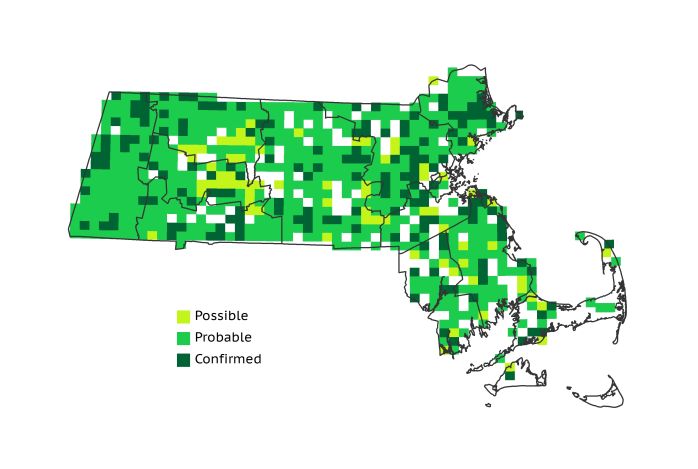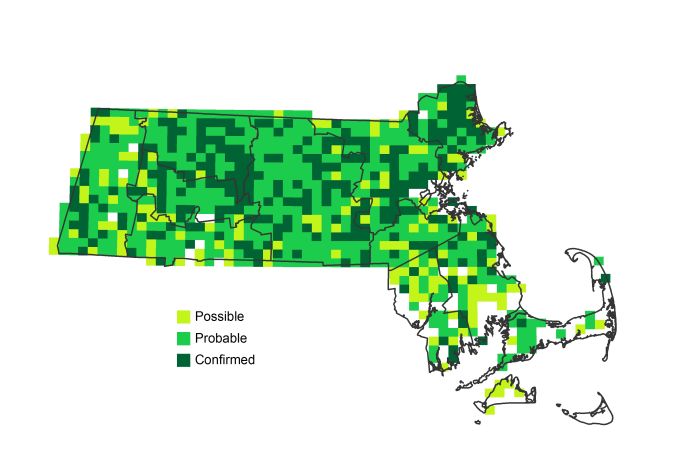Find a Bird
Scarlet Tanager
Piranga olivacea

Nearly ubiquitous and stable
Action/monitoring needed

“A carol like a glory came / From topmost twig astir, / Enkindled by a flying flame, / The scarlet tanager.” – Katharine Lee Bates, “In the Oak”
A bird as brilliantly colored as the Scarlet Tanager might seem at first to be impossible to overlook. It happens however that this vibrant forest bird is improbably gifted at evading the birder’s eye as it sluggishly moves about the forest canopy, singing its hoarse song as it searches for caterpillars to eat. Like several other mature forest species, Scarlet Tanagers seemed to be doing well in Atlas 2, but they are showing signs of declining abundance.
Historic Status
Long known as a friend to the orchard owner, the Scarlet Tanager has rarely been the target of slings, arrows, or buckshot, but instead the subject of praise through the written word. Florence Augusta Merriam Bailey likened the male to a “Bird of Paradise in our northern landscape” (Chapman 1901), while Edward Howe Forbush described the species as flashing through the trees “like a brand plucked from a tropical flame,” (Forbush 1907). Forbush also perceived an increase in the species in the last three decades of the nineteenth century, possibly an indication of the beginning of the end of the farming era and the return of deciduous or mixed deciduous-coniferous forests to Massachusetts.
Atlas 1 Distribution
Scarlet Tanagers, found in 75% of the blocks surveyed during Atlas 1, bred widely throughout the state. The forested regions west of the Connecticut River Valley had greater than 90% block occupancy. Block occupancy dipped to 80% in the Connecticut Valley itself, likely due to the extensive amount of still-cleared farmland. The north-central Lower Worcester Plateau seemingly stood as a tanager-free island in the otherwise well-occupied center of the state in Atlas 1, possibly as an artifact of survey effort. The species was widespread as far east as the Coastal Plains, though it was not as ubiquitous as in the western regions. In the Bristol/Narragansett Lowlands (72% block occupancy) and the Boston Basin (61%), Scarlet Tanagers were present but more local, and a lack of mature mixed forest on Cape Cod and the Islands resulted in only 29% of those blocks reporting Scarlet Tanagers.
Atlas 2 Distribution and Change
By the time of Atlas 2 Scarlet Tanagers gained ground, and they had climbed to 81% block occupancy in the state. They showed marked growth in most regions where they were not already saturated, particularly in the Coastal Plains where they greatly increased their footprint. Their numbers declined slightly in the Bristol/Narragansett Lowlands and on Cape Cod, and they remained absent from Nantucket.
Atlas 1 Map

Atlas 2 Map

Atlas Change Map

Ecoregion Data
Atlas 1 | Atlas 2 | Change | ||||||
Ecoregion | # Blocks | % Blocks | % of Range | # Blocks | % Blocks | % of Range | Change in # Blocks | Change in % Blocks |
Taconic Mountains | 15 | 93.8 | 2.1 | 25 | 100.0 | 3.0 | 0 | 0.0 |
Marble Valleys/Housatonic Valley | 39 | 100.0 | 5.4 | 39 | 100.0 | 4.6 | 0 | 0.0 |
Berkshire Highlands | 53 | 96.4 | 7.3 | 53 | 96.4 | 6.3 | -1 | -1.9 |
Lower Berkshire Hills | 28 | 100.0 | 3.9 | 27 | 87.1 | 3.2 | -1 | -3.7 |
Vermont Piedmont | 16 | 94.1 | 2.2 | 17 | 100.0 | 2.0 | 1 | 8.3 |
Berkshire Transition | 35 | 92.1 | 4.8 | 40 | 100.0 | 4.8 | 0 | 0.0 |
Connecticut River Valley | 45 | 80.4 | 6.2 | 57 | 87.7 | 6.8 | 4 | 8.3 |
Worcester Plateau | 68 | 87.2 | 9.4 | 87 | 98.9 | 10.4 | 2 | 4.2 |
Lower Worcester Plateau | 63 | 85.1 | 8.7 | 80 | 100.0 | 9.5 | 4 | 7.4 |
S. New England Coastal Plains and Hills | 212 | 78.5 | 29.3 | 261 | 92.2 | 31.1 | 25 | 11.1 |
Boston Basin | 34 | 60.7 | 4.7 | 38 | 67.9 | 4.5 | 4 | 7.3 |
Bristol and Narragansett Lowlands | 76 | 71.7 | 10.5 | 74 | 64.9 | 8.8 | -3 | -3.0 |
Cape Cod and Islands | 39 | 28.7 | 5.4 | 41 | 28.5 | 4.9 | -4 | -3.3 |
Statewide Total | 723 | 74.6 | 100.0 | 839 | 80.9 | 100.0 | 31 | 3.7 |
Notes
Despite this apparent stability in breeding footprint, the Breeding Bird Survey (BBS) shows significant declines in Scarlet Tanager’s abundance for Massachusetts and the New England/Mid-Atlantic Region. They fall into our “whispering bird” category – those species with a demonstrated stable or increasing breeding footprint from Atlas 2 data, but also a demonstrated decline in abundance from the BBS. This drives our final assessment that this is a species with a need for further monitoring and conservation action.



